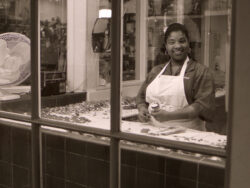Pralines
The praline, a confection made of sugar and nuts, is a representative dish of the Franco- and Afro-Creole Atlantic diasporas.

Tom Driggers via Wikimedia Commons
Woman making pralines in New Orleans shop, 1999.
The praline, a confection made of sugar and nuts, is a representative dish of the Franco- and Afro-Creole Atlantic diasporas.
In a perhaps apocryphal story, César, duc de Choiseul, comte du Plessis-Praslin, a seventeenth-century French diplomat, inspired his cook, possibly one Clément Lassagne, to name the sweet invention in his honor. Originally made of caramelized sugar and almonds, pralines were a treat for the elite, as both ingredients were a luxury. Mirroring similar sweets like nougats, brittles, and marzipans, various iterations of the praline have since migrated across the wider Francophone world, including Louisiana.
Along the Gulf Coast, but especially in New Orleans, pralines remain ubiquitous. The candy is made with chopped pecans folded into a mixture of sugar, butter, and milk or cream. Occasionally vanilla, molasses, or caramel is added. Boiled, then constantly stirred over medium-low heat, the creamy mixture thickens to a fudge-like consistency. The resulting caramel-colored batter is spooned into ovular shapes onto a butter-greased surface or parchment paper and allowed to cool. Today, everything from ice cream to bacon features praline bits or flavors.
Though tales credit the Ursuline nuns’ arrival in the 1720s, this is no doubt a fanciful bit of Crescent City mythmaking. Sugar and milk were rare commodities in eighteenth-century Louisiana. The earliest historical mentions of pralines in fact appear in late-nineteenth-century newspapers, which trace the candy’s beginnings to the antebellum era, when fashionable, affluent white households served platters of pecan pralines with meals.
Following the American Civil War and emancipation, Black women became intrinsically tied to the praline in New Orleans. Colloquially called marchands des pralines (praline vendors) or pralinières (praline sellers), these women sold homemade pralines, in baskets, along the city’s streets and sidewalks. Alongside the now-traditional pecan praline, they sometimes sold pralines flavored with chocolate, a cochineal-dyed version called “pink poodles,” and a coconut-flavored variety named “white mice.” A distinctively sticky praline, sometimes made without milk or cream, arose in rural Louisiana and Texas.
Several of these pralinières became local celebrities of a sort. Praline Zizi occupied a corner of the French Quarter’s Jackson Square. Mary Louise plied her praline trade on Tulane’s campus. Drawings of them appear in cookbooks from the era. Ethnographers recorded their street-vendor songs. Newspaper accounts documented their lives.
Often dressed in an apron and tignon headscarf, these pralinières used the romanticized and racialized antebellum tropes that this uniform conveyed to assert their own entrepreneurial spirit, economic freedom, and independence. Unfortunately tourist shops, especially in the French Quarter, continue to advertise pralines with this outdated imagery today. Though nowhere near the numbers of a century ago, a few independent pralinières still sell the candy along city sidewalks.
